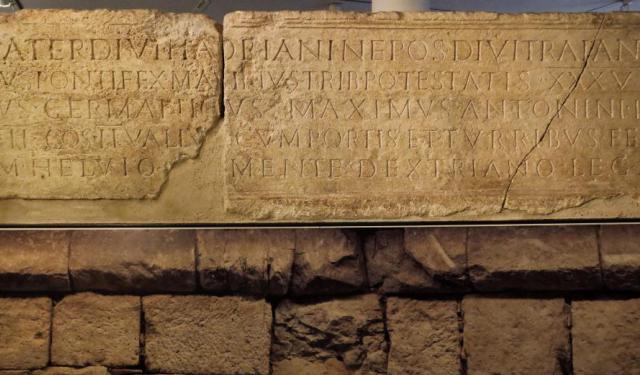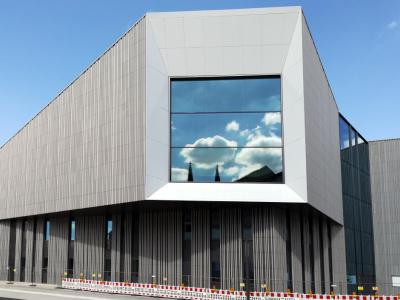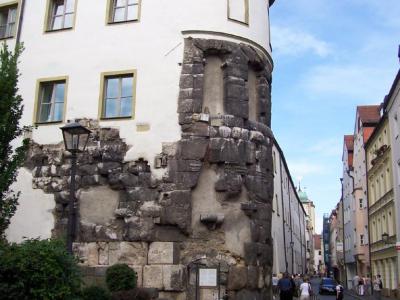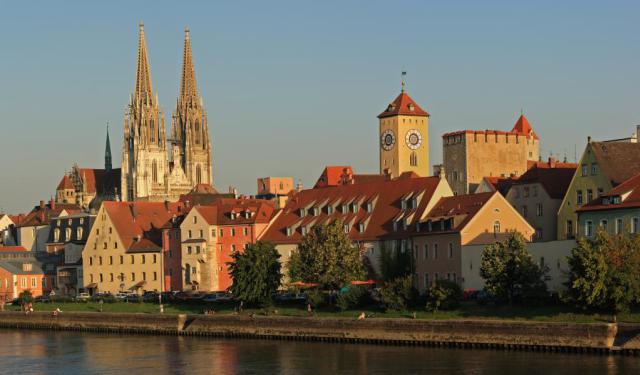
Roman Ruins Walking Tour (Self Guided), Regensburg
Meandering through the Old Town of Regensburg, it’s easy to forget that some 1800 years ago most of this area was occupied by a Roman fortress. Although the first settlement here dates from as early as the Stone Age, it is the Romans who put it firmly on the map.
Around 90 AD, they first built an expeditionary and then a permanent military camp called Castra Regina ("Fortress by the River Regen"), in 179 AD, during the reign of Emperor Marcus Aurelius. Designed to accommodate the 3rd Italian Legion (Legio III Italica), the rectangular fort measured 540 x 450 meters and was fit to house up to 6,000 soldiers.
Important for its location, at the junction of the Danube and Regen rivers, this outpost formed part of the Roman Empire’s northern frontier (the so-called Danubian Limes) and corresponded roughly to what is now the core of Regensburg's Altstadt (Old Town). It was surrounded by a mighty wall comprising large ashlars with towers and a wide moat in front of it.
By the 3rd century AD, the camp had an extensive civilian suburb with residential and commercial buildings, shops, villas, sanctuaries, and a large bathing complex ("therme"). In the 5th century, constant Barbarian raids and migrations forced the Romans to abandon the fort, but the large ashlar wall of the legionary camp continued to protect the early medieval town long after they left. The east side of the fortress wall served as a city wall during the High Middle Ages and was repaired accordingly; hence the large portions thereof have been preserved.
Today, traces of the Roman-era buildings and remnants of the legionary camp fortifications are found both under and above ground in the heart of Regensburg. Perhaps the most prominent of them is the former north gate to Castra Regina, called Porta Praetoria, the largest surviving Roman building in Bavaria.
Other impressive relics include a long section of the Roman wall uncovered during the construction of a multi-story car park in Dachau Square (Dachauplatz), as well as fragments of the north- and south-east corners of the wall that once encircled the Roman camp. Together they are featured in the multimedia "Legion Camp Wall Document" ("Document Legionslagermauer”).
If Regensburg is "The Jewel of Bavaria", then Castra Regina is undoubtedly the jewel of its Roman part. To learn more about the Roman legacy of this former imperial outpost in the Danubian region, take our self-guided historical tour.
Around 90 AD, they first built an expeditionary and then a permanent military camp called Castra Regina ("Fortress by the River Regen"), in 179 AD, during the reign of Emperor Marcus Aurelius. Designed to accommodate the 3rd Italian Legion (Legio III Italica), the rectangular fort measured 540 x 450 meters and was fit to house up to 6,000 soldiers.
Important for its location, at the junction of the Danube and Regen rivers, this outpost formed part of the Roman Empire’s northern frontier (the so-called Danubian Limes) and corresponded roughly to what is now the core of Regensburg's Altstadt (Old Town). It was surrounded by a mighty wall comprising large ashlars with towers and a wide moat in front of it.
By the 3rd century AD, the camp had an extensive civilian suburb with residential and commercial buildings, shops, villas, sanctuaries, and a large bathing complex ("therme"). In the 5th century, constant Barbarian raids and migrations forced the Romans to abandon the fort, but the large ashlar wall of the legionary camp continued to protect the early medieval town long after they left. The east side of the fortress wall served as a city wall during the High Middle Ages and was repaired accordingly; hence the large portions thereof have been preserved.
Today, traces of the Roman-era buildings and remnants of the legionary camp fortifications are found both under and above ground in the heart of Regensburg. Perhaps the most prominent of them is the former north gate to Castra Regina, called Porta Praetoria, the largest surviving Roman building in Bavaria.
Other impressive relics include a long section of the Roman wall uncovered during the construction of a multi-story car park in Dachau Square (Dachauplatz), as well as fragments of the north- and south-east corners of the wall that once encircled the Roman camp. Together they are featured in the multimedia "Legion Camp Wall Document" ("Document Legionslagermauer”).
If Regensburg is "The Jewel of Bavaria", then Castra Regina is undoubtedly the jewel of its Roman part. To learn more about the Roman legacy of this former imperial outpost in the Danubian region, take our self-guided historical tour.
How it works: Download the app "GPSmyCity: Walks in 1K+ Cities" from Apple App Store or Google Play Store to your mobile phone or tablet. The app turns your mobile device into a personal tour guide and its built-in GPS navigation functions guide you from one tour stop to next. The app works offline, so no data plan is needed when traveling abroad.
Roman Ruins Walking Tour Map
Guide Name: Roman Ruins Walking Tour
Guide Location: Germany » Regensburg (See other walking tours in Regensburg)
Guide Type: Self-guided Walking Tour (Sightseeing)
# of Attractions: 5
Tour Duration: 1 Hour(s)
Travel Distance: 1.4 Km or 0.9 Miles
Author: nataly
Sight(s) Featured in This Guide:
Guide Location: Germany » Regensburg (See other walking tours in Regensburg)
Guide Type: Self-guided Walking Tour (Sightseeing)
# of Attractions: 5
Tour Duration: 1 Hour(s)
Travel Distance: 1.4 Km or 0.9 Miles
Author: nataly
Sight(s) Featured in This Guide:
- Museum of Bavarian History
- Northeast Corner Roman Wall Remaints
- Porta Praetoria (Praetorian Gate)
- "Document Legionslagermauer” in Dachau Square
- Southeast Corner of the Fortress Wall
1) Museum of Bavarian History
The Museum of Bavarian History is a significant cultural institution in Regensburg. Constructed to commemorate the centenary of the Bavarian Free State and the 200th anniversary of the state's constitution, this museum has quickly become one of the country's most important and popular attractions.
Located on the picturesque banks of the Danube River, the Museum of Bavarian History offers a comprehensive exploration of Bavaria's rich history, focusing on the period from the 1800s to modern times. Through state-of-the-art multimedia experiences, visitors can immerse themselves in the captivating stories of generations of Bavarians during this era. The museum utilizes innovative technologies to create engaging and interactive exhibits that bring history to life.
The museum features a diverse range of displays showcasing artifacts, documents, and memorabilia related to Bavarian culture, language, and sports. Visitors can discover the region's traditions, customs, and significant events through carefully curated exhibitions.
The Regensburg Museum of History also houses one of the most extensive permanent exhibitions dedicated to the Roman era in Germany. As visitors embark on their exploration, they will encounter a significant artifact right at the beginning: the slab bearing the fort gate inscription. Originally believed to have been positioned above the entrance of the east gate, this historical slab was discovered in two fragments during excavations on Dachau Square in 1873. The inscription on the slab signifies the year 179, marking the completion of the legionary fort. This inscription serves as Regensburg's foundational certificate and holds immeasurable value in the town's history.
Within the museum, an impressive model showcases the construction of the legionary fortress wall surrounding the Porta Praetoria. This model offers a particularly intriguing glimpse into the building process, illustrating each step from the transportation of ashlar blocks by boat to the riverside, to the meticulous preparation of the stones, and finally to their skillful stacking using cranes.
Located on the picturesque banks of the Danube River, the Museum of Bavarian History offers a comprehensive exploration of Bavaria's rich history, focusing on the period from the 1800s to modern times. Through state-of-the-art multimedia experiences, visitors can immerse themselves in the captivating stories of generations of Bavarians during this era. The museum utilizes innovative technologies to create engaging and interactive exhibits that bring history to life.
The museum features a diverse range of displays showcasing artifacts, documents, and memorabilia related to Bavarian culture, language, and sports. Visitors can discover the region's traditions, customs, and significant events through carefully curated exhibitions.
The Regensburg Museum of History also houses one of the most extensive permanent exhibitions dedicated to the Roman era in Germany. As visitors embark on their exploration, they will encounter a significant artifact right at the beginning: the slab bearing the fort gate inscription. Originally believed to have been positioned above the entrance of the east gate, this historical slab was discovered in two fragments during excavations on Dachau Square in 1873. The inscription on the slab signifies the year 179, marking the completion of the legionary fort. This inscription serves as Regensburg's foundational certificate and holds immeasurable value in the town's history.
Within the museum, an impressive model showcases the construction of the legionary fortress wall surrounding the Porta Praetoria. This model offers a particularly intriguing glimpse into the building process, illustrating each step from the transportation of ashlar blocks by boat to the riverside, to the meticulous preparation of the stones, and finally to their skillful stacking using cranes.
2) Northeast Corner Roman Wall Remaints
The Northeast Corner Roman Wall Remains provide a fascinating glimpse into the ancient history of the city. These remnants, situated on Saint George Square, stand up to 10 feet (3 meters) in height and are a testament to the former legionary fortress wall.
The discovery of these remains took place in 1905 during the demolition of the pawnbroker department's accounting offices, which were located next to the high medieval Haller Gate. The demolition process not only revealed the northeast corner of the Roman wall but also uncovered the east side of the Saint George and Afra Chapel, including its Romanesque window.
While the outer facing ashlars have not been preserved, the surviving masonry provides valuable insights into the original construction. The irregularly placed stones make it difficult to identify specific components from the original construction period, such as a relatively flat front, a protruding podium, or the beginnings of a corner tower. Instead, the remaining stone blocks likely belonged to the inner face of the broad ashlar masonry.
Despite the absence of some key architectural elements, the Northeast Corner Roman Wall Remains offer a tangible link to the past. Standing tall on Saint George Square, they serve as a reminder of the ancient Roman presence in Regensburg and provide a fascinating glimpse into the city's historical development. Visitors can marvel at these ancient remnants and imagine the grandeur of the former legionary fortress wall that once surrounded the area.
The discovery of these remains took place in 1905 during the demolition of the pawnbroker department's accounting offices, which were located next to the high medieval Haller Gate. The demolition process not only revealed the northeast corner of the Roman wall but also uncovered the east side of the Saint George and Afra Chapel, including its Romanesque window.
While the outer facing ashlars have not been preserved, the surviving masonry provides valuable insights into the original construction. The irregularly placed stones make it difficult to identify specific components from the original construction period, such as a relatively flat front, a protruding podium, or the beginnings of a corner tower. Instead, the remaining stone blocks likely belonged to the inner face of the broad ashlar masonry.
Despite the absence of some key architectural elements, the Northeast Corner Roman Wall Remains offer a tangible link to the past. Standing tall on Saint George Square, they serve as a reminder of the ancient Roman presence in Regensburg and provide a fascinating glimpse into the city's historical development. Visitors can marvel at these ancient remnants and imagine the grandeur of the former legionary fortress wall that once surrounded the area.
3) Porta Praetoria (Praetorian Gate)
The Praetorian Gate is an impressive historical landmark and holds the distinction of being Germany's oldest surviving stone building. This ancient gateway, constructed in 179 A.D., stands as a testament to the Roman presence in the region and serves as a reminder of the Roman settlement known as Castra Regina.
Situated in the northern wall of the Roman military camp, the Praetorian Gate was built using massive blocks of stone. Its solid construction has allowed it to endure throughout the centuries, retaining its historical significance. The gateway is strategically positioned, facing the point where the River Regen flows into the Danube, emphasizing its importance in the defense and access of the Roman camp.
Over time, the Praetorian Gate became integrated into subsequent buildings, and its true age and historical significance remained unrecognized until 1885. The gateway's rough-hewn stone blocks provide a glimpse into the architectural techniques and craftsmanship of the Roman period.
The Praetorian Gate stands as an important historical landmark, offering visitors a chance to appreciate the rich history and architectural legacy left by the Romans in Regensburg. Its presence serves as a tangible reminder of the city's Roman origins and provides a fascinating glimpse into the past.
Situated in the northern wall of the Roman military camp, the Praetorian Gate was built using massive blocks of stone. Its solid construction has allowed it to endure throughout the centuries, retaining its historical significance. The gateway is strategically positioned, facing the point where the River Regen flows into the Danube, emphasizing its importance in the defense and access of the Roman camp.
Over time, the Praetorian Gate became integrated into subsequent buildings, and its true age and historical significance remained unrecognized until 1885. The gateway's rough-hewn stone blocks provide a glimpse into the architectural techniques and craftsmanship of the Roman period.
The Praetorian Gate stands as an important historical landmark, offering visitors a chance to appreciate the rich history and architectural legacy left by the Romans in Regensburg. Its presence serves as a tangible reminder of the city's Roman origins and provides a fascinating glimpse into the past.
4) "Document Legionslagermauer” in Dachau Square
Located in the Dachau Square is the impressive "Document Legionslagermauer." This remarkable site can be explored through a captivating digital presentation at the information center situated in the basement of the car park. To access it, visitors can use the staircase accessible from Königs Street.
Within this underground space, a section of the fortification measuring approximately 230 feet (70 meters) in length and up to five ashlar layers high has been preserved. This represents the longest remaining straight segment of the Roman wall in existence.
As you descend the steep staircase into the basement, you'll immediately notice the variation in height between the Roman habitation layer, indicated by the wall's podium, and the current street level. This eastern section of the legionary fortress once formed part of the city walls until the early fourteenth century when it was repurposed for the convent of the Poor Clares and eventually filled in. Although the ashlars undoubtedly originate from the Roman period, modifications and repairs from later periods are discernible.
On the car park basement wall, across from the Roman wall, you'll find a regular-sized and a large monitor displaying a twelve-minute video presentation. This video provides insights into the legionary fortress wall, with a particular focus on the uncovering and details of this specific section. Additionally, there is another video explaining the construction history of the southeast corner of the Roman wall.
Within this underground space, a section of the fortification measuring approximately 230 feet (70 meters) in length and up to five ashlar layers high has been preserved. This represents the longest remaining straight segment of the Roman wall in existence.
As you descend the steep staircase into the basement, you'll immediately notice the variation in height between the Roman habitation layer, indicated by the wall's podium, and the current street level. This eastern section of the legionary fortress once formed part of the city walls until the early fourteenth century when it was repurposed for the convent of the Poor Clares and eventually filled in. Although the ashlars undoubtedly originate from the Roman period, modifications and repairs from later periods are discernible.
On the car park basement wall, across from the Roman wall, you'll find a regular-sized and a large monitor displaying a twelve-minute video presentation. This video provides insights into the legionary fortress wall, with a particular focus on the uncovering and details of this specific section. Additionally, there is another video explaining the construction history of the southeast corner of the Roman wall.
5) Southeast Corner of the Fortress Wall
The southeast corner of the former Roman fortress holds historical significance and is now a part of the "document Legionslagermauer." Through archaeological excavations carried out in 1955 and 1961, a large conservation zone was established, allowing for a remarkable glimpse into the structure of the Roman fort's wall.
During that time, Horst Bergschneider, a notable resident of Regensburg, played a crucial role in fundraising and raising awareness for the preservation of the Roman wall at this particular location. His dedication and efforts were commendable and had a significant impact.
Exploring this area, visitors can witness the impressive curvature of the southeast corner of the legionary fortress, which seamlessly connects to the northward and westward extensions of the legionary wall. Notably, the remains of the podium with its characteristic slant are still visible. At the top of the curve, there is a rubble wall, likely added during the Middle Ages to replace a protruding corner tower.
Towards the north, the ruins of a medieval fortified tower merge with the Roman masonry, demonstrating the transition from Roman to medieval fortification at this site. This combination emphasizes the remnants of the lower bailey, including a tower dating back to 1389.
Interestingly, both of these walls continued to serve their defensive purpose until the early 19th century. Only after Regensburg was bombarded and attacked by Napoleonic troops in 1809 did their defensive role diminish. As a result, large portions of the walls were removed and filled in, contributing to the protection of the lower section of the Roman wall.
During that time, Horst Bergschneider, a notable resident of Regensburg, played a crucial role in fundraising and raising awareness for the preservation of the Roman wall at this particular location. His dedication and efforts were commendable and had a significant impact.
Exploring this area, visitors can witness the impressive curvature of the southeast corner of the legionary fortress, which seamlessly connects to the northward and westward extensions of the legionary wall. Notably, the remains of the podium with its characteristic slant are still visible. At the top of the curve, there is a rubble wall, likely added during the Middle Ages to replace a protruding corner tower.
Towards the north, the ruins of a medieval fortified tower merge with the Roman masonry, demonstrating the transition from Roman to medieval fortification at this site. This combination emphasizes the remnants of the lower bailey, including a tower dating back to 1389.
Interestingly, both of these walls continued to serve their defensive purpose until the early 19th century. Only after Regensburg was bombarded and attacked by Napoleonic troops in 1809 did their defensive role diminish. As a result, large portions of the walls were removed and filled in, contributing to the protection of the lower section of the Roman wall.
Walking Tours in Regensburg, Germany
Create Your Own Walk in Regensburg
Creating your own self-guided walk in Regensburg is easy and fun. Choose the city attractions that you want to see and a walk route map will be created just for you. You can even set your hotel as the start point of the walk.
Regensburg Introduction Walking Tour
"The jewel of Bavaria," as some affectionately refer to it, the German city of Regensburg is the biggest medieval site north of the Alps. Although its history spans nearly 2,000 years, here, the past does not seem like a distant memory and its weight blends seamlessly with the pulse of modern life.
The precursor to Regensburg, a military camp called Castra Regina ("Fortress by... view more
Tour Duration: 2 Hour(s)
Travel Distance: 4.1 Km or 2.5 Miles
The precursor to Regensburg, a military camp called Castra Regina ("Fortress by... view more
Tour Duration: 2 Hour(s)
Travel Distance: 4.1 Km or 2.5 Miles
The Most Popular Cities
/ view all






